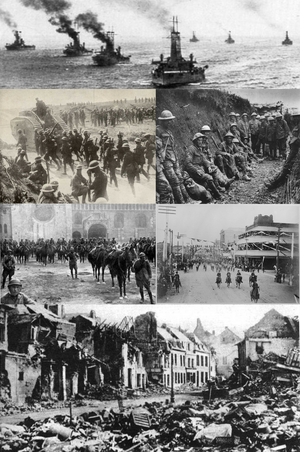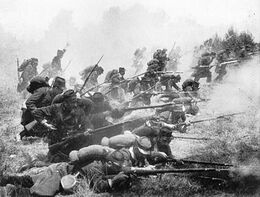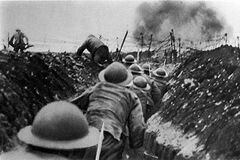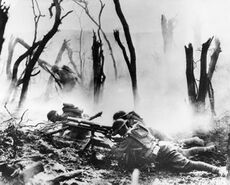Great War (Aurorum): Difference between revisions
The ©rusader (talk | contribs) |
|||
| Line 78: | Line 78: | ||
===Opening fightings=== | ===Opening fightings=== | ||
====Dulebian and Cuthish ambitions for Rovina==== | ====Dulebian and Cuthish ambitions for Rovina==== | ||
===Western | ===Western Front=== | ||
====Dulebian offensive and entrenchment==== | |||
====Summer offensive of 1911 and the frontline stall==== | |||
====Bakunin's offensive and the Dulebian revolution==== | |||
===Naval war=== | ===Naval war=== | ||
===Eastern Theatre=== | ===Eastern Theatre=== | ||
Revision as of 23:50, 1 September 2020
This article is incomplete because it is pending further input from participants, or it is a work-in-progress by one author. Please comment on this article's talk page to share your input, comments and questions. Note: To contribute to this article, you may need to seek help from the author(s) of this page. |
| Great War | |||||||
|---|---|---|---|---|---|---|---|
 (Clockwise from the top)
| |||||||
| |||||||
| Belligerents | |||||||
|
X |
X | ||||||
| Commanders and leaders | |||||||
|
|
| ||||||
| Strength | |||||||
|
Total: 3,920,294 |
Total: 5,130,000 | ||||||
| Casualties and losses | |||||||
|
Military dead: 495,204 Military deaths by country |
Military dead: 991,852 Military deaths by country | ||||||
The Great War, also known as the Great Berean War or the World War, was a significant global conflict primarily between nations in Siantria and Telmeria in Berea and overseas in Caphtora and Pamira, that lasted from 1910 to 1916. Having reached a never before seen scale, it led to the mobilisation of more than 20 million military personnel, making it one of the largest wars ever fought. With an estimated three million combatants and one million civilian deaths as a direct consequence of the war, it is also one of the deadliest conflicts in history. The conflict began on September 7, 1910 following X. It lasted until the unilateral surrender of remaining X powers on May 29, 1916 and peace was declared following the Treaty of Lehpold in early 1917.
TBD
The Continental War at large was a political, economic, cultural, and social turning point for the world. it is generally considered to mark an end to the age of colonial empires in Berea, and saw the dissolution of multiple influential states and the deterioration of others' powers. The war and its immediate aftermath saw a number of revolutions and uprisings in Dulebia, Cuthland, Mascylla, and X. Through the political instability, the Big Three (Albeinland, Lavaria and Mascylla; the principal X members and war victors) emerged their power as great powers and imposed their demands on the defeated enemies in a treaty drafted and signed in 1917—the Treaty of Lehpold. Ultimately, the intergovernmental organisation of the Assembly of Nations was founded to spearhead international cooperation and to prevent another large-scale conflict.
Background
| Events leading to the Great War | ||||||||||||||||||||||||
|---|---|---|---|---|---|---|---|---|---|---|---|---|---|---|---|---|---|---|---|---|---|---|---|---|
 | ||||||||||||||||||||||||
|
||||||||||||||||||||||||
Political atmosphere and ambitions
Arms race
Tensions in Berea
Prelude
The war
Opening fightings
Dulebian and Cuthish ambitions for Rovina
Western Front
Dulebian offensive and entrenchment
Summer offensive of 1911 and the frontline stall
Bakunin's offensive and the Dulebian revolution
Eastern Theatre
Northern Front
Cuthish advances

The Northern Front was one of the main theatres of war during the Great War. Following the outbreak of war in September 1910, the Cuthish army opened the Northern Front by first invading the cities of Bad Ülerst and Saarow, which prompted the Mascyllary Kingdom to hastily muster their defences without prior tactical decisionmaking. Therefore, the Cuthish was able to penetrate Mascyllary defences at their border and sweep into the Fanian Plain, quickly gaining military control over important industrial regions in Mascylla. The First Battle of Augusthal proved to be the backbone of any further advances and the obliteration of large-scale Mascyllary military resistance for half a year.
With too little forces set up in time and a chaotic retreat as a result, Mascylla suffered heavy territorial losses in the first months and year of the war. Having reached an unbearable toll on Mascyllary morale and resources, government officials began demanding for a peace truce. However, the tide was turned dramatically in the Battle of Lückwalde and by pure chance with the destaster at Marienfelde where a large portion of the Cuthish forces were swiftly wiped out and saving Königsreh in the process. With Mascylla beginning to hold ground against Cuthland, the front now established between Pereuth on the coast of the White Sea to Konreid at Lake Sigismund began to solidify, despite costly efforts by both sides to lift the stalemate. Furthermore, numerous attempts to open a second front in southern Gothia remained ineffective.
By the end of 1911, the opposing forces were left confronting each other along an uninterrupted line of entrenched positions in central Mascylla. Since the Cuthish were able to choose where to stand, they normally had the advantage of the high ground; in addition, their trenches tended to be better built, since Mascyllary trenches were initially intended as "temporary," preparatory to breaking the Cuthish defences.
Trench warfare and progress of the war
Between 1913 and 1914 several offensives along this front were tried. The attacks employed massive artillery bombardments and waves of infantry divisions. Entrenchments, machine gun emplacements, barbed wire and artillery repeatedly inflicted severe casualties during attacks and counter-attacks and no significant advances were made. Among the most costly of these offensives were the Second Battle of Augusthal, in autumn of 1913, with a combined 600,000 casualties (estimated), the Battle of the Rohrn beginning in Summer of 1914, with more than a million casualties (estimated), and the Battle of Seifritz, in 1915/16, with 487,000 casualties (estimated). Gun fire wasn't the only factor taking lives; the diseases that emerged in the trenches were a major killer on both sides. The terrible living conditions were the origin of a number of diseases and health issues as trench foot, shell shock, blindness/burns from mustard gas, lice, trench fever, cooties (body lice) and other.

To break the deadlock of trench warfare on the Northern Front, both sides tried new military technology advantages, including poison gas as part of gas warfare, the introduction of military aircraft, and the development of tanks by Mascylla in 1914, essentially contributing to the resolve of trench warfare in the war. The adoption of better tactics and the cumulative weakening of the armies in the west led to the return of mobility in 1916. The Cuthish Storm Offensive, beginning in 1916, led to the devastation of entire regions and further heavy casalties without any advances made, beginning with what is described as a "blunting war". Using short, intense "hurricane" bombardments and infiltration tactics, the Cuthish and Mascyllary armies moved nearly 100 kilometres (60 miles) back and forth to the west and east, the deepest advance by either side since 1910, but the result was indecisive and very costly on human lifes and material used.
The unstoppable advance of the Mascyllary armies during the Three Months Offensive in 1916 caused a graduating collapse of the Cuthish armies and finally persuaded the Cuthish commanders that defeat was inevitable. The offensive was greatly effective, and by 1916 Mascyllary armies had advanced deeply into Cuthish territory and to the cities of Cingsham and Alderport. The Cuthish government surrendered in the armistics of 29 May 1916, and the terms of peace were settled by the Treaty of Lehpold in 1917.
Southern Front
Aftermath
Peace treaties and geopolitical changes
Treaty of Lehpold
Main article: Treaty of Lehpold
See also
- ↑ Prior to the Bakunin's Breakthrough in May 1913

